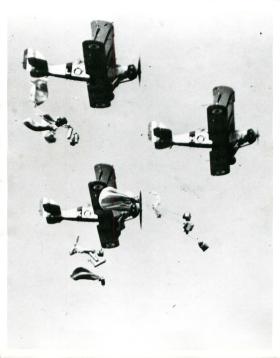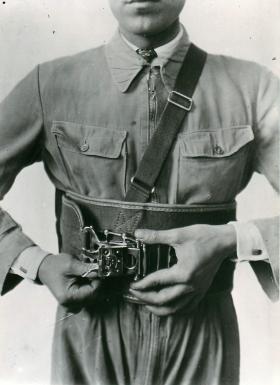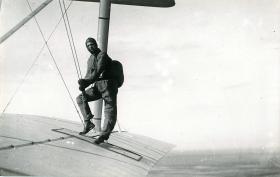The Italians were among the very first to see the potential of airborne warfare, dropping agents behind Austrian lines during World War I. Military experiments with paratroopers began in 1927 with a drop at Cinisello near Milan. The Italians used the Salvatore parachute operated by a hand grip on the belt or static line.
The death of General Allesandro Guidoni, the founder of Italian airborne forces in a parachuting accident in 1928 slowed further development. Airborne re-supply of air-dropped animals was made in support of Mountain troops during the campaign in Ethiopia in 1937.
In March 1938 Marshal Balbo the Governer of Libya formed a 300-strong 1st Battalion of the Air recruited from native colonial volunteers officered by Italians. A parachute school was established at Castel Benito near Tripoli, while a 2nd Battalion was formed in Italy. Parachute training at Castel Benito cost 15 dead and 72 seriously injured, which resulted in the second established Libyan battalion being disbanded and re-formed, this time composed entirely of Italian volunteers. The two battalions were formed into a Parachute Regiment.
By November 1940 there was an Army and Carabinari parachute battalion under training. Two parachute regiments were raised between April-August 1941. One battalion was parachuted onto the Greek Island of Cephalonia. Both regiments fought in North Africa.
At the end of 1941 the Folgore Parachute Division was established and ear-marked for a proposed air invasion of Malta. They were eventually overrun at El Alamain on the Egyptian border in November 1942, fighting with the German Afrika Korps as line-infantry.
The Nembo Parachute Division in Italy fought in Sicily in 1943 and continued operating with the Germans after the Italian Armistice and Allied invasion in September.
Despite the effort expended on parachute development between the wars, Italian parachutists fought no major airborne actions during the Second World War.
The present day Italian Army airborne component includes the Folgore Parachute Brigade in Tuscany, with a parachute training centre, four parachute regiments and Special Forces assault regiment. These are supplemented by the Friuli Air Assault Brigade, an Alpini Parachute Regiment and an Aviation Regiment.
Italian Airborne Forces
Newsletter Signup
Donate
Donate
Make a donation to Airborne Assault ParaData to help preserve the history of The Parachute Regiment and Airborne Forces
The Airborne Shop
The Airborne Shop
The Airborne Shop is the official shop of Support Our Paras (The Parachute Regiment Charity RCN1131977).
Profits from all sales made through our shop go directly to Support Our Paras, so every purchase you make with us will directly benefit The Parachute Regiment and Airborne Forces.











Latest Comments
There are currently no comments for this content.
Add Comment
In order to add comments you must be registered with ParaData.
If you are currently a ParaData member please login.
If you are not currently a ParaData member but wish to get involved please register.